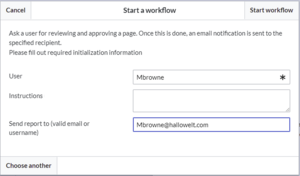Description
The CustomForm activity is a generic activity, which is based on a custom form. It collects data for the corresponding workflow, which shall be executed. Therefore, the input fields depend on the type of workflow, which is chosen by the user. In general, the data is always the same and differs only in relation to the particular workflow and the number of users required. The CustomForm activity mostly include blank values, which can also be inserted by default. This is related to the metadata maintenance associated with the use of wikitext.
| Short profile | |
|---|---|
| Name | CustomForm |
| Async | No |
| Input/form | Input depends on the workflow type, but in general:
|
| BPMN Element | bpmn:userTask
|
| BPMN Extension Element "wf:type" | custom_form
|
Extension elements
| Name of extension element | Description | Type |
|---|---|---|
| formModule | element | |
| formModule/module | ResourceLoader module to be loaded | string |
| formModule/class | Form definition class to be shown | string |
Example
<bpmn:extensionElements>
<wf:type>custom_form</wf:type>
<wf:formModule>
<wf:module>my.custom.form</wf:module>
<wf:class>MyCustomForm</wf:class>
</wf:formModule>
</bpmn:extensionElements>
This would load the ResourceLoader module called my.custom.form and expect it to have a JavaScript class MyCustomForm be implemented. Such a RL module may be provided by an extension, or a custom gadget.
Properties
| Name of property | Source | Description | Type |
|---|---|---|---|
due_date
|
UIActivity | Due date for task completion | date/timestamp |
Each field provided by the form specified in formModule/class needs to be listed as a property with a default value.
Example
If the form specified in <wf:class> looks like this
MyCustomForm = function( cfg, activity ) {
MyCustomForm.parent.call( this, cfg, activity );
};
OO.inheritClass( MyCustomForm, workflows.object.form.Form );
MyCustomForm.prototype.getDefinitionItems = function() {
return [
{
name: 'username',
label: "Username",
type: 'user_picker',
required: true
},
{
name: 'comment',
label: 'Comment'
type: 'wikitext',
}
];
};
the properties can look like this
<bpmn:property name="username" />
<bpmn:property name="comment" default="Some default comment text" />
Given the activities id specified in the <bpmn:userTask> element was "CollectData", connected activities would be able to access the output data in their respective properties like this:
<bpmn:task id="SomeActivity">
...
<bpmn:property name="user" default="{{{CollectData.username}}}"></bpmn:property>
<bpmn:property name="intro" default="{{{CollectData.comment}}}"></bpmn:property>
...
